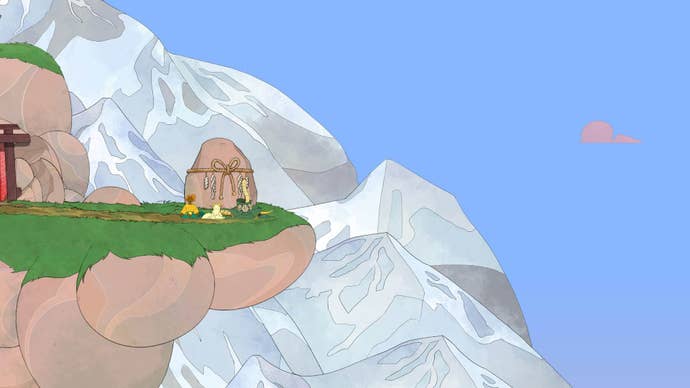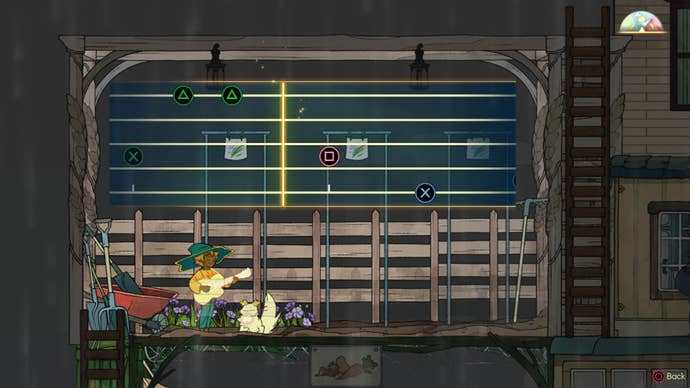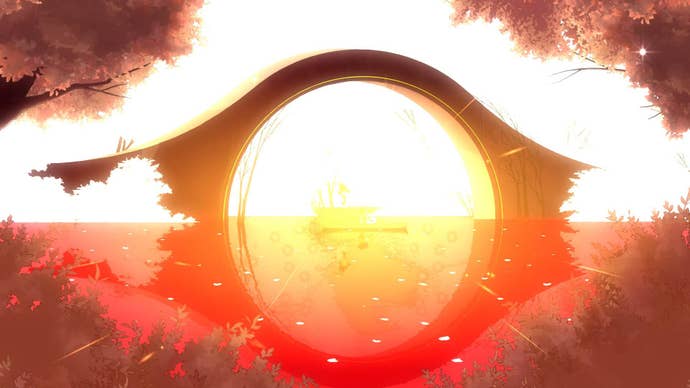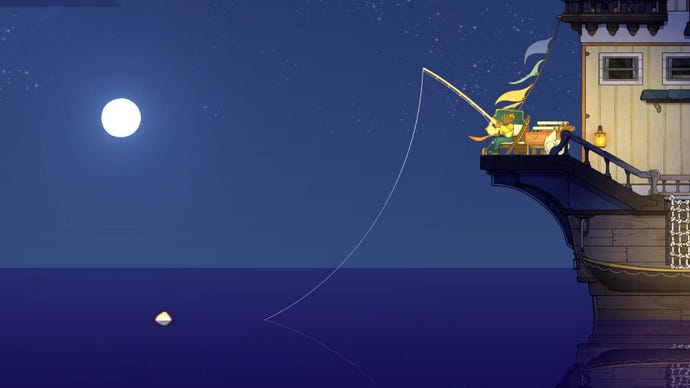Spiritfarer Review: Come Sail Away
Set sail for resources and hugs aplenty.
This article first appeared on USgamer, a partner publication of VG247. Some content, such as this article, has been migrated to VG247 for posterity after USgamer's closure - but it has not been edited or further vetted by the VG247 team.
At some point, I lost track of the number of times I performed certain tasks in Spiritfarer. Over the course of only a few hours, I might hack a dozen trees down and turn them into two or three times as many planks. Every rock smashed, crop tended, sheet of metal, and hunk of ore curved and crafted became blocks for my next building. No seafaring vessel should be as tall as my ridiculous boat.
Spiritfarer, from developer Thunder Lotus Games, is a management game at its core, and that entails a lot of resource gathering and juggling multiple branching production lines. It's all beautifully masked by the simple nature of each related minigame, and the dreamlike world it imagines. All those bountiful resources I've harvested for hours on end will result in a gift, one that will make someone smile and get them ever closer to acceptance of what's left in life's allotment for them. It is a bittersweet, cozy game about dying.
The story of Spiritfarer opens with Charon, the mythical boatman of the river Styx, handing the reins off to your character, Stella, and her cat Daffodil. Armed with the Everlight, Stella becomes the new Spiritfarer—a guide for dying spirits from here to the hereafter. After acquiring a proper nautical vessel befitting the afterlife's ferry, Stella hosts a number of spirits and gives them comfort so they can conquer any lingering fears or wants before heading to what lies beyond.
It might sound morbid, but Spiritfarer masks this with a beautiful style. Drawing inspiration from both Studio Ghibli and the paintings of Yoshida Hiroshi, Spiritfarer is consistently gorgeous, whether in just drifting through the waves, or exploring the tops of mountains replete with trees, tents, and geysers.
Caring for the spirits entails a number of things. One part is basic upkeep: they need to be fed, housed, and every so often, hugged. The happier they are, the more they contribute to your boat, completing menial tasks, or offering extra raw material.
In a broader sense, each spirit has their own journey to complete. Spiritfarer is set in a massive ocean dotted with islands, inhabited by cloaked denizens that only shed their robes and don an animal appearance once their time on Stella's boat has come. Finding these spirits in need is only the first part; each character will also ask to be taken to various locales, request certain tasks, or simply inquire about their favorite meal.

These quests often take place over long stretches of time, making Stella's boat feel like a rotating door through which spirits can come and go. Yet no matter how many I had on board, each character felt clearly defined and endearing. Summer, the elderly snake, was a constant source of warmth, whose music would lift the crops in my garden. Astrid is the strongest, sassiest, yet secretly most vulnerable character, but on a good day, I would often find her forging ingots in the Foundry. Gustav? Well, he didn't do too much. But I liked his violin playing, and he always gave me odd little trinkets that I could sell for more Glims, the game's currency.
While one character's journey might be all about building the ultimate museum exhibit or pulling off one last job, others are simpler: revisiting painful memories, or even just clinging to the little joys in life as their memories start to fade away. It can be an absolute tearjerker at times, and though it feels like some symbolism was left intentionally vague, it's easy to understand what each character is going through. The spirits, as Charon tells you from the outset, must all eventually depart, and it's your job to see to it.
As you complete these tasks, you can also build a burgeoning city aboard your ship. Some of the buildings are bespoke houses for each spirit, giving them home and a slice of their old life, but the others are all about production. Spiritfarer has most of the resource gathering and crafting staples you might expect: gardening to grow crops, tending to animals, smelting ore and steel to create new products. Zinc, an ore that became incredibly precious near the end of the game, starts life as an ore. These can be turned into Ingots in the Foundry, then smelted into various styles of plates, or used wholesale as building components for new construction.
All of these operate on various timers, and managing the timers to produce as efficiently as possible is what fills most of the in-between of Spiritfarer. It takes time to travel by ship, even after a fast travel system is unlocked. During this time, you might need to water crops, harvest or plant new ones, and then cook more food to feed your hearty crew of spirits.

These tasks also have their own requisite minigames. Some are fairly simple, but others can get pretty complex. By the time I saw credits roll, I was sure I could spool linen on the loom or play the crop-growing tunes with my eyes closed. Yet I always overheated certain ores, and rarely spent less than three thwacks of my light-molded pickaxe on a single rock. I'll get the timing at some point, I swear. There are a myriad of tasks to do, from gathering to crafting and even mini-events involving platforming, and it can occasionally get hard to keep track of just where to find certain things, acquire certain resources, or where your boat should head next.
In its best moments, especially early on, Spiritfarer's pacing feels really solid. I was constantly zipping between tasks, and all of them felt fruitful. By the middle of the game though, I was having to focus on very specific resources, watching the islands that held the few precious ores I needed or hunting across islands for the right kind of tree to chop down. The management side of Spiritfarer rarely bottlenecks, but when it does, the sudden (sometimes literal) wall in your path is felt.
Aside from some fairly light platforming, most of Spiritfarer is spent in this loop. Get new tasks from a spirit, head out to a location, complete the task, move on to another, filling every gap in the between with resource management. During most in-game days, I wasn't just thinking about what I needed for one quest, but what I needed for everything on my docket. I might be doing a small request for Giovanni, the lion casanova, but I'm also keeping an eye out for islands where I can harvest for another resident's home improvement.
It can, at times, get almost too much to handle. Chalk part of this up to the fact that I blitzed through most of Spiritfarer in the course of one weekend; its many systems feel better suited to much, much shorter gameplay sessions. Spiritfarer feels like the kind of game that's best to play an hour or two at a time, where you can pick up the controller, do a few tasks, advance a plotline, and always feel productive. There is no outright failure state or pressure to do something as soon as possible. This cozy management sim wants to be taken at whatever pace you feel is best.

A few minor tweaks would help as well, like being able to preview islands while selecting a fast travel point. There were points where characters would block whatever action I was doing, resulting in a comical moment of waiting to strike with my hammer until Bruce and Mickey moved their collectively large behind. Other times, I needed to break out pen and paper to remember which resources I was collecting, and which product they needed to be turned into.
But through constant deliveries and tasks, you get to know a person. The revelations might be big, like one of Stanley's unique mannerisms revealing a hurtful truth about his upbringing. Or they might be sweet and simple, like remembering a spirit's favorite food and serving it to them after a particularly difficult event. The words of kindness they return, even just the virtual hug that follows, is a reward as much as a new blueprint or a token that advances Stella's abilities. In our current global climate, doing small kindnesses and hugging sad animals is a nice reprieve.
Of course, the spirits have to leave. They all do. Their place is not here anymore, and it's brutal every time. For some, the end comes suddenly; for others, it's painfully visible from miles away, as you inch closer and closer with each quest, until finally the spirit says the words you've been dreading: "Stella, it's time."

There is a deeper meta-narrative involving a particularly haunting owl and Stella's own journey. To even begin to dissect how the surreal nature of all these encounters could tie together gets very spoiler-y, very fast. It is a moving story, even if it's not the explicit thing I will remember Spiritfarer for.
Spiritfarer, similar to games like What Remains of Edith Finch, ponders the question of what we leave behind when we pass on to whatever's next. The houses of former spirit residents took up space on my boat as the hours went on, each a large, empty reminder of the character that used to live there with a single flower left behind.
But I still thought of Summer every time I played music to hasten the growth of my crops, or Gwen when I spooled the loom. When I cooked something that I knew my pickiest eaters wouldn't stomach, I thought, "Well at least Atul will eat it." I kind of missed him hammering away at the ship, even if the other spirits were happy to have less racket.
Spiritfarer is a management sim at its core, one that's at its best when you can see the benefit of them. Its writing is warm, funny, and charming, and it explores death and what it means, especially for the still living, from various angles. Some tension happens when those systems bottleneck and gate progress, or quests pile up and minigames blur together. It can feel expansive with the sheer breadth of activities and things to do, but underlying all of it is a very bittersweet story I'd be happy to revisit.
ConclusionSpiritfarer is a cozy game about helping spirits move on. Its wide scope of systems and resources can sometimes get in its own way, but when working in harmony it unveils a touching narrative, all the while adorned by gorgeous art. Best enjoyed in small pieces, Spiritfarer is a warm and inviting world to get lost in, with the occasional emotional gut punch for good measure.





